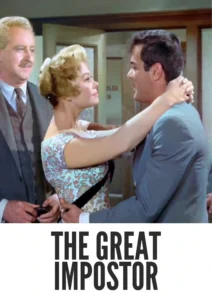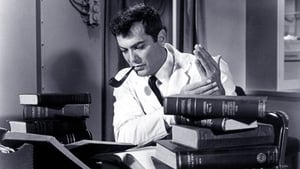Contact: info@alwanfilm.com
Video Sources 0 Views

Synopsis
The Great Impostor 1960 Colorized Review: A Classic Tale of Deception and Identity

Introduction
In the realm of classic cinema, The Great Impostor (1960) stands out as a fascinating exploration of identity, deception, and the lengths to which one man will go to reinvent himself. Directed by Robert Mulligan and starring Tony Curtis in one of his most charismatic roles, this film tells the incredible true story of Ferdinand Waldo Demara, a man who audaciously posed as a doctor, a monk, a prison warden, and a myriad of other professions—all without the necessary qualifications. The movie’s light-hearted yet thought-provoking narrative captivated audiences upon its release, and it continues to intrigue viewers to this day. In this article, we will delve into the film’s themes, cast performances, directorial choices, and the legacy it has left in the world of cinema.
Check The Full Colorized Movies List
Check Our Colorized Movies Trailer Channel
Understanding The Great Impostor 1960 Colorized: Director, Cast, and Genre
Director’s Vision
Robert Mulligan, known for his keen eye for character-driven storytelling, directed The Great Impostor with a delicate balance of humor and drama. Mulligan, who would later achieve great acclaim for his direction of To Kill a Mockingbird (1962), showcases his skill in blending the biographical with the comedic. His vision for The Great Impostor was to depict the unbelievable true events of Demara’s life with a sense of levity while also probing deeper questions about identity and human nature. Mulligan’s direction transforms what could have been a mere recounting of extraordinary events into a profound examination of one man’s psyche, highlighting the absurdity and ingenuity of Demara’s escapades.
The Iconic Performance of Tony Curtis
Tony Curtis, one of Hollywood’s most versatile stars of the 1950s and 60s, delivers a standout performance as Ferdinand Waldo Demara. Curtis’s portrayal is both charming and complex, capturing the wit and audacity of a man who lived a life of deception. Known for his roles in films like Some Like It Hot (1959) and Sweet Smell of Success (1957), Curtis uses his natural charisma to bring Demara’s larger-than-life personality to the screen. His performance oscillates between humorous and poignant, allowing audiences to both laugh at and sympathize with a character who is perpetually running from himself.
The supporting cast includes notable performances from Karl Malden as a suspicious colleague and Edmond O’Brien as Demara’s disappointed father figure, adding layers to the narrative and giving Curtis ample opportunity to shine. Each supporting actor brings their own gravitas, helping to create a dynamic ensemble that keeps the film engaging from start to finish.
Exploring the Genre
The Great Impostor (1960) straddles multiple genres, including biographical drama, comedy, and adventure. While rooted in true events, the film’s tone often veers into the comedic, reflecting the absurdity of Demara’s deceptions. It is this blend of genres that makes the film so distinctive; it refuses to be pigeonholed, much like its protagonist. The film’s narrative structure, which jumps from one outrageous impersonation to the next, mirrors the unpredictability of Demara’s life, keeping viewers on their toes and continually entertained.
Exploring the World of The Great Impostor 1960 Colorized: Plot and Characters
Detailed Synopsis
The Great Impostor follows the real-life exploits of Ferdinand Waldo Demara (played by Tony Curtis), a man with an uncanny ability to assume the identities of others without ever being discovered. The film opens with Demara’s early realization that he is not content with a conventional life. Lacking formal education but blessed with intelligence and charm, Demara embarks on a life of impersonation, beginning with a stint as a college professor.
The narrative then takes viewers on a whirlwind tour of Demara’s various guises: a Trappist monk, a doctor on a Canadian Navy ship, a prison warden, and more. Each role is fraught with potential pitfalls, yet Demara’s quick thinking and unshakeable confidence allow him to succeed in situations where failure seems inevitable. The film highlights key moments, such as Demara performing life-saving surgeries on wounded soldiers despite having no medical training—a scene that encapsulates both the absurdity and the danger of his deceptions.
Throughout his journey, Demara encounters individuals who question his credentials, yet his sheer audacity and persuasive skills enable him to continue his charade. The film ultimately portrays Demara as a complex character: a conman, but one whose motivations are not rooted in malice but in a desperate desire to be seen as important and accomplished.
The Complex Protagonist and Memorable Supporting Characters
Ferdinand Waldo Demara is a character of contradictions—brilliant yet deceitful, kind-hearted yet dishonest. Tony Curtis’s portrayal ensures that Demara is more than just a charming trickster; he is a deeply flawed individual whose actions reflect a profound search for identity. The supporting cast, including Karl Malden as Dr. Joseph C. Cyr (whose identity Demara famously assumes) and Joan Blackman as Mary, Demara’s love interest, provides a moral counterbalance to Demara’s antics. Each supporting character brings out different facets of Demara’s personality, from his vulnerability to his relentless ambition.
The Art of Film Colorization
Understanding the Process
Although The Great Impostor was originally filmed in black-and-white, colorization has allowed modern audiences to experience the film in a new light. Film colorization involves the addition of color to monochrome footage using digital technology. This process often requires careful attention to detail, as it involves matching colors to historical references and ensuring that the visual quality aligns with the film’s original aesthetic.
Development Over Time
The early days of colorization were met with technical limitations, but advancements in digital technology have significantly improved the process. The colorization of The Great Impostor brings a new layer of visual appeal to the film, highlighting its vibrant 1960s settings and enhancing the overall viewing experience. For some, the addition of color breathes new life into the classic, while for others, it represents a departure from the film’s authentic roots.
Early Colored Films: A Brief History
Emergence of Early Colored Techniques
Before films were produced in full color, various techniques such as hand-tinting, toning, and Technicolor were used to add visual flair to movies. Technicolor, introduced in the early 1930s, was the most prominent and reliable process, allowing filmmakers to create vivid, lifelike images. These early color films marked a turning point in cinema, making movies more immersive and visually captivating.
The Great Impostor remains in black and white, yet it stands as a testament to the charm and effectiveness of monochrome storytelling. Its subsequent colorization connects it to a long tradition of films being adapted to meet modern tastes, preserving the narrative while offering a fresh visual take.
The Great Impostor and Its Early Colored Version
The Decision to Release in Color
The decision to release a colorized version of The Great Impostor reflects a broader trend in film preservation and adaptation. For audiences unaccustomed to black-and-white films, the addition of color can make classic movies feel more accessible and engaging. Colorization is not just about updating the visuals; it’s about reintroducing classic narratives to new generations in a format that resonates with contemporary viewers.
Impact on the Visual Narrative
Colorizing The Great Impostor brings a new dimension to its storytelling, particularly in scenes where setting and costume play crucial roles. The vibrant hues of 1960s fashion and the distinctive settings—such as hospitals, monasteries, and naval ships—are given a newfound vividness. However, this change can also alter the mood and tone originally intended by the filmmakers, prompting debate among purists about the impact of such changes on the integrity of classic films.
The Debate Over Film Colorization
Controversy Surrounding Colorization
The debate over film colorization often centers around issues of artistic integrity and historical authenticity. Some critics argue that colorization can distort the original vision of the director and alter the audience’s perception of a film’s themes. For movies like The Great Impostor, which were crafted with a specific aesthetic in mind, colorization may inadvertently shift the tone or message.
Supporters of colorization, however, see it as a valuable tool for keeping classic films relevant. They argue that color can make older films more appealing to today’s audiences, who are accustomed to vibrant, high-definition visuals. The colorized version of The Great Impostor serves as an example of this ongoing debate—inviting viewers to consider what is gained and what might be lost in the process.
Examining The Great Impostor as an Early Colored Film
Enhancement or Distraction?
For some, the colorization of The Great Impostor enhances the experience, adding vibrancy and helping to differentiate the various identities that Demara adopts throughout the film. The visual update brings attention to the details of the settings and costumes, enriching the viewing experience. However, others feel that the black-and-white format is more suited to the film’s themes of deception and moral ambiguity, lending a certain timeless quality that color cannot replicate.
Influence and Legacy: TThe Great Impostor 1960 Colorized’s Impact on Cinema
The Biographical Film Trend
The Great Impostor helped popularize the biographical film genre, particularly stories about real-life con artists and individuals who defy societal norms. Its influence can be seen in later films like Catch Me If You Can (2002), which similarly tells the story of a charming imposter. By blending humor with biographical drama, The Great Impostor set a precedent for how such stories could be told on screen, making them entertaining while still addressing deeper themes of identity and morality.
Director’s Cinematic Legacy: Beyond The Great Impostor 1960 Colorized
Robert Mulligan’s Influence
Robert Mulligan’s direction in The Great Impostor showcases his ability to handle complex, character-driven narratives—a skill that would define his career. Beyond this film, Mulligan continued to explore themes of personal struggle and societal expectations in movies like To Kill a Mockingbird and Summer of ’42 (1971). His work is characterized by a deep empathy for his characters, and The Great Impostor is no exception.
Themes Explored in The Great Impostor
Deception, Identity, and Morality
At its core, The Great Impostor is a film about identity—how we define ourselves and how others perceive us. The themes of deception and morality are central to Demara’s story, challenging viewers to consider the ethical implications of his actions. The film does not glorify his deceptions but rather presents them as a complex mix of ambition, desperation, and skill.
Reception and Controversy Surrounding The Great Impostor 1960 Colorized
Critical Reception and Audience Reactions
Upon release, The Great Impostor received positive reviews, with critics praising Curtis’s performance and Mulligan’s direction. The film was seen as a lighthearted yet poignant look at an extraordinary life, and its mix of comedy and drama appealed to a broad audience. The subsequent colorization of the film reignited interest but also sparked discussions about the preservation of classic cinema.
Where to Watch The Great Impostor 1960 Colorized Online
The Great Impostor is available on various streaming platforms, including Amazon Prime Video and iTunes. Both the original black-and-white and the colorized versions can be found, offering viewers a choice in how they wish to experience this classic film. Physical copies are also available for those who prefer to own a piece of cinema history.
FAQs About The Great Impostor 1960 Colorized
Q: What is the main theme of The Great Impostor (1960)?
A: The film explores themes of identity, deception, and the human desire for reinvention. It delves into the moral complexities of living a life built on lies.
Q: Who plays the lead role in The Great Impostor?
A: Tony Curtis stars as Ferdinand Waldo Demara, delivering a performance that captures the charm and cunning of the real-life imposter.
Q: Is the colorized version of The Great Impostor widely accepted?
A: Opinions on the colorized version vary, with some appreciating the updated visuals and others preferring the original black-and-white format for its authenticity.
Conclusion
The Great Impostor (1960) remains a captivating exploration of a man who defied conventions and continually reinvented himself. Through Robert Mulligan’s direction and Tony Curtis’s unforgettable performance, the film captures the absurdity and allure of Demara’s life. The debate over its colorization highlights the ongoing conversation about how we preserve and reinterpret classic films. Whether in black and white or color, The Great Impostor endures as a testament to the power of storytelling and the complex nature of human identity.














